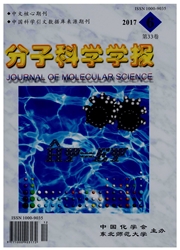

 中文摘要:
中文摘要:
基团的电子、共轭、超共轭、空间位阻、溶剂化等效应在有机酸碱理论及酸碱性分析中一直占据主导地位.但在气相状态下,分析某些物质的酸碱性时单用上述理论远不能满足要求,得不到与实验事实相符的结果.从热力学及分子统计力学角度出发,以量子化学为辅助,研究了分子熵值及其构象改变对物质酸碱性、反应活性、反应速率的影响.提出理想状态下“分子自由行走”、“自由均方行走距”等假设,并以此演绎出理想状态下有机分子构象改变所遵循的统计规律——“类自由结合链高斯模型”.建立了“分子熵效应笼敝扩散”分子构象模型,用该理论成功解释了气相状态下甲、乙、丙、丁、戊、己酸酸性大小差异及气相氨、伯胺、仲胺、叔胺、苯胺、二苯胺的碱性差异.结果表明:自由均方行走距及分子笼敝大小是影响物质活性的关键因素.
 英文摘要:
英文摘要:
Various group effects, including electron, conjugativity, super-conjugativity, steric resistivity, and solvent effect, play a dominant role in organic chemistry and the analysis of acidity and alkaliscence. However, in gas phase, it is very inadequate to analyse them only using above theories, not getting accordant with experiments. From the point of thermodynamics and molecular statistical mechanics, with the assistant of quantum chemistry, molecular entropy and the influence of conformational transition on acidity and alkalescence, reactive activity, and reaction rate are investigated in this paper. Several hypothesises, molecular flexible transition in the ideal state is put forward. On the basis of which the statistical law of freely jointed molecular chain-Gaussian model that the conformational change of organic molecules follow in the ideal state is deduced. Model of molecule flexible transition, i. e., cage-barriers of molecular entropy is established. According to this theory the following two problems can be successfully explained: (1) acidities of different organic acids in gas phase; (2) alkalescences of different organic bases in gas phase.The results show that mean square radius of molecule flexible transition and the magnitude of molecular cage-barriers are key factors influencing activity.
 同期刊论文项目
同期刊论文项目
 同项目期刊论文
同项目期刊论文
 The preparation of core-shell CaCO3 particles and its effect on mechanical property of PVC composite
The preparation of core-shell CaCO3 particles and its effect on mechanical property of PVC composite Effect of pentaerythitol and organic tin with calcium/zinc stearates on the stabilization of poly(vi
Effect of pentaerythitol and organic tin with calcium/zinc stearates on the stabilization of poly(vi 期刊信息
期刊信息
